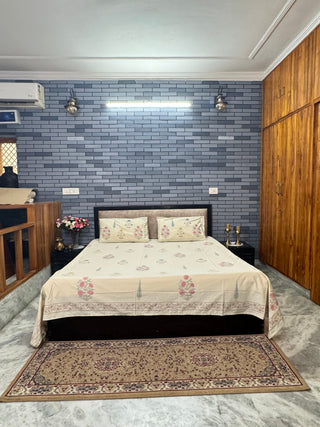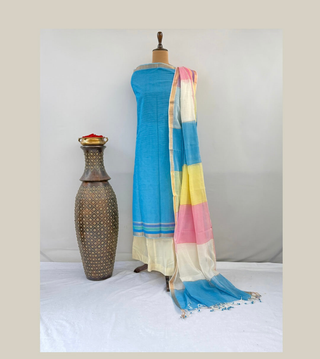
Lehariya designs are inspired by natural patterns made by the wind blowing across the deserts sands of Rajasthan in India. The name is derived from the word ‘Leher’, which means waves. Lehriya is inspired by the wave like pattern on the san dunes of the desert. The fabric is printed in vibrant colours. Being the daughter of a India Army Officer, I had the wonderful opportunity of living in the region and experiencing these beauties of nature and cultural at a very young age. I was in awe of this art and the capability of the people to get inspired from something from nature and show it such beautifully on clothes. When we were a Lehriya print cloth, we wear the cultural, values and natural beauty of the region.
Origins and Legacy
Lehriya print traces its origins to the heartland of Rajasthan, where skilled artisans have been practicing the art of tie-and-dye for generations. Lehariya design reflects the characteristic rippling effect created by the intricate dyeing process. This traditional craft has been passed down through the ages, with each generation adding its own unique flair to the art form.
Techniques and Process
At the heart of Lehriya print lies the intricate technique of tie-and-dye, wherein fabric is folded, tied with thread, and then dyed in vibrant colours to create mesmerising patterns. The process begins with preparing the fabric, followed by folding, twisting, and tying it in various ways to achieve the desired design. Artisans then carefully immerse the fabric in dye baths, allowing the colours to penetrate the unbound areas while the tied sections remain untouched. The result is a stunning array of colourful wave like patterns and stripes that cascade across the fabric in a mesmerising dance of hues.
Motifs and Designs
Lehriya print is characterised by its bold patterns, dynamic colors, and inspired by the natural beauty. Common motifs include diagonal stripes, zigzag patterns, and geometrical shapes. The vibrant colours used in Lehriya print, ranging from bright red, pink, yellows and fiery oranges to deep blues and lush greens adding to the allure of the fabric. Every colour has its own social significance in Rajasthany society and it’s social hierarchy. Leheriya symbolises prosperity, and women give each as a token of love and auspiciousness. This is especially true for the new brides or brides-to-be, who are gifted a leheriya saree by their mother-in-law. This ritual is known as Sinjara, and is testament to Rajasthan's rich cultural heritage and the significance of its crafts in society.
Exquisite Mothara design, an extension of lehriya are created with additional dyeing using the same leheria technique. In the making of mothara, the original resists thread are removed and the fabric is re-rolled and tied along the opposite diagonal. This creates a beautiful checkered pattern with small undyed areas occurring at regular intervals. The undyed areas are about the size of a Moth bean(lentil) which is mainly grown in the area.
Contemporary Relevance
In modern times, Lehriya print continues to captivate audiences with its timeless charm and versatile appeal. While traditional techniques remain integral to the craft, contemporary designers have also embraced innovation by experimenting with new colour palettes, fabric combinations, and design motifs to cater to diverse tastes and preferences. Lehriya print fabrics are widely used in fashion apparel, home furnishings, and accessories, adding a touch of reach and royal Indian elegance and sophistication.

